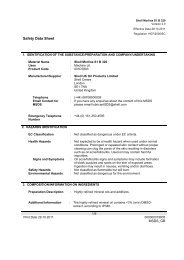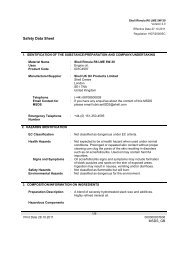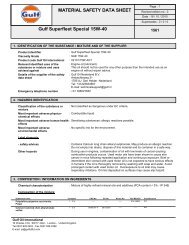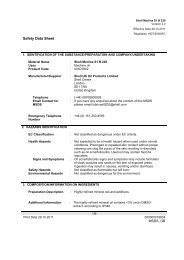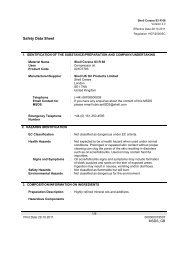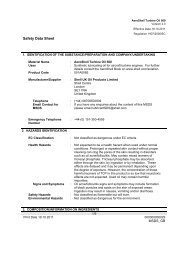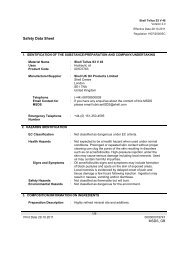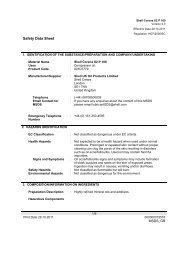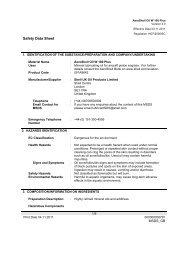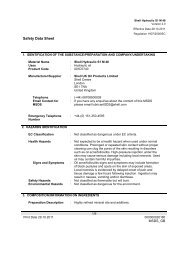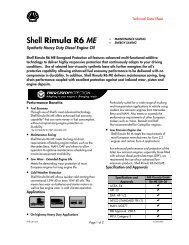Gadus S3 V220C 2.pdf - OilsandStuff
Gadus S3 V220C 2.pdf - OilsandStuff
Gadus S3 V220C 2.pdf - OilsandStuff
Create successful ePaper yourself
Turn your PDF publications into a flip-book with our unique Google optimized e-Paper software.
Material Safety Data Sheet<br />
Shell <strong>Gadus</strong> <strong>S3</strong> <strong>V220C</strong> 2<br />
Version 1.0<br />
Effective Date 02.12.2010<br />
Regulation 1907/2006/EC<br />
depending upon potential exposure conditions. Select controls<br />
based on a risk assessment of local circumstances.<br />
Appropriate measures include: Adequate ventilation to control<br />
airborne concentrations. Where material is heated, sprayed or<br />
mist formed, there is greater potential for airborne<br />
concentrations to be generated.<br />
Personal Protective<br />
Equipment<br />
: Personal protective equipment (PPE) should meet<br />
recommended national standards. Check with PPE suppliers.<br />
Respiratory Protection : No respiratory protection is ordinarily required under normal<br />
conditions of use. In accordance with good industrial hygiene<br />
practices, precautions should be taken to avoid breathing of<br />
material. If engineering controls do not maintain airborne<br />
concentrations to a level which is adequate to protect worker<br />
health, select respiratory protection equipment suitable for the<br />
specific conditions of use and meeting relevant legislation.<br />
Check with respiratory protective equipment suppliers. Where<br />
air-filtering respirators are suitable, select an appropriate<br />
combination of mask and filter. Select a filter suitable for<br />
combined particulate/organic gases and vapours [boiling point<br />
>65 °C (149 °F)] meeting EN14387.<br />
Hand Protection : Where hand contact with the product may occur the use of<br />
gloves approved to relevant standards (e.g. Europe: EN374,<br />
US: F739) made from the following materials may provide<br />
suitable chemical protection: PVC, neoprene or nitrile rubber<br />
gloves. Suitability and durability of a glove is dependent on<br />
usage, e.g. frequency and duration of contact, chemical<br />
resistance of glove material, glove thickness, dexterity. Always<br />
seek advice from glove suppliers. Contaminated gloves should<br />
be replaced. Personal hygiene is a key element of effective<br />
hand care. Gloves must only be worn on clean hands. After<br />
using gloves, hands should be washed and dried thoroughly.<br />
Application of a non-perfumed moisturizer is recommended.<br />
Eye Protection : Wear safety glasses or full face shield if splashes are likely to<br />
occur. Approved to EU Standard EN166.<br />
Protective Clothing : Skin protection not ordinarily required beyond standard issue<br />
work clothes.<br />
Monitoring Methods : Monitoring of the concentration of substances in the breathing<br />
zone of workers or in the general workplace may be required to<br />
confirm compliance with an OEL and adequacy of exposure<br />
controls. For some substances biological monitoring may also<br />
be appropriate.<br />
Environmental Exposure<br />
Controls<br />
9. PHYSICAL AND CHEMICAL PROPERTIES<br />
: Minimise release to the environment. An environmental<br />
assessment must be made to ensure compliance with local<br />
environmental legislation.<br />
Appearance<br />
: Red. Semi-solid at ambient temperature.<br />
Odour<br />
: Slight hydrocarbon.<br />
pH<br />
: Not applicable.<br />
Initial Boiling Point and : Data not available<br />
Boiling Range<br />
Dropping point : Typical 240 °C / 464 °F<br />
Flash point<br />
: > 250 °C / 482 °F (COC)<br />
Print Date 03.12.2010<br />
4/8<br />
MSDS_GB



